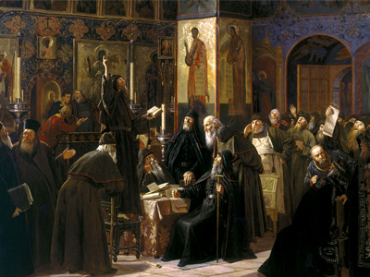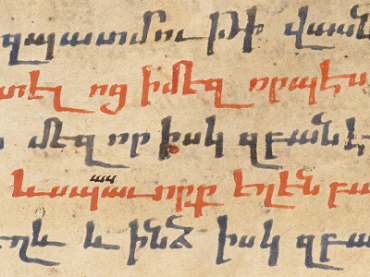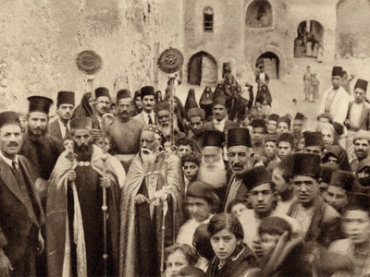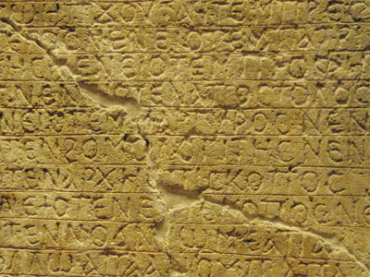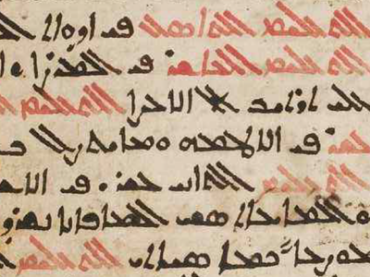Syriac and Eastern Christianity
Greek Tradition and Latin Influence in the Work of George Scholarios
“Alone Against All of Europe”
ISBN: 978-1-59333-344-7
This title is a study of the work and career of theologian and diplomat George Scholarios who became the first Ecumenical Patriarch of the Orthodox Church during the period of Ottoman Rule. Scholarios advocated the union of the Greek and Latin Churches, but he later became the leader of the anti-Unionist faction in the final years of the Byzantine Empire. Scholarios played an important role in East-West dialogues, including the Council of Ferrara-Florence in 1438-39. This book provides a fresh look at some of the cultural misunderstandings that took place at the Council and related dialogues.
$124.00
Astronomie et cosmographie syriaques
Recueil d'articles de François Nau
Introduits et annotés par Emilie Villey & Henri Hugonnard-Roche
ISBN: 978-1-4632-0235-4
Cette série s’ouvre par la réédition d’articles de François Nau, publiés entre 1896 et 1910 dans la Revue de l’Orient chrétien et le Journal asiatique. L’œuvre de François Nau au service de la culture syriaque est immense et toujours consultée, tant il s’est consacré à la publication de textes qui n’ont souvent pas encore été repris ailleurs. Il a donc semblé utile de les republier dans une série de volumes thématiques, qui couvriront tous les champs de la culture syriaque.
$165.00
Sleep and Sleeplessness in Byzantium
ISBN: 978-1-4632-0237-8
In recent decades certain historians have intimated that Byzantine society - and monastics in particular - suffered from a lack of sleep (whether described in negative terms as sleep deprivation or sleep abstinence). Sleep-abstinence surely permeated Byzantine society: it is encountered in every age, sex and class, together with its institutions, beliefs, practices, rituals, morals and mythologies. However, sleep is a biological phenomenon as well. One cannot possibly appreciate the Byzantines' stance towards it, nor assess the veracity, aims and effectiveness of their ideas and attitudes in relation to sleep-abstinence, unless one is ready to tackle the biological aspect. Moreover, without the biological aspect, the claim that the Byzantines were sleep-deprived is impossible to substantiate. This book approaches this subject by using a bio-cultural method, which combines sleep medicine with theology, history, and critical research, in order to analyse the practice of sleep-abstinence and the attitudes towards sleep in Byzantium. Focusing on Greek documentary sources, this book investigates whether Byzantines did indeed practice sleep abstinence or sleep deprivation, and their rationales for curtailing their sleep. Chapters cover the mechanics of sleep in the modern world and in the ancient world, the place of monastic vigil, and the vigil of the laity.
$169.00
Journal of the Canadian Society for Syriac Studies 13
Edited by Amir Harrak
ISBN: 978-1-4632-0244-6
Volume 13 includes articles by Mark Dickens, Pier Giorgio Borbone, Nicholas Al-Jeloo, Emanuela Braida, Khairy Foumia, Rima Smine, Khalid Dinno and Amir Harrak.
$75.00
Syriac Christianity in the Middle East and India
Contributions and Challenges
Edited by Dietmar W. Winkler
ISBN: 978-1-4632-0247-7
This volume acknowledges the contributions of Syriac Christians in the fields of culture, education and civil society throughout the history in the Middle East and India, and examines the challenges of living and professing the Christian faith as a minority in a multi-religious and pluralistic society, giving special attention to religious freedom and personal status.
$165.00
Epiphanius von Salamis, Über die zwölf Steine im hohepriesterlichen Brustschild (De duodecim gemmis
nach dem Codex Vaticanus Borgianus Armenus 31 herausgegeben und übersetzt
Series: Gorgias Eastern Christian Studies 37
ISBN: 978-1-4632-0279-8
At the request of Diodorus, bishop of Tyre, Epiphanius of Salamis produced this exegetical treatise on the gemstones in the High Priest's breastplate. The oldest Christian work on gemstones, the the author deals with the stones according to their appearance and their medical benefit as well as their attribution to the twelve tribes based on Christian exegesis. Only extracts of this work are preserved in Greek. This volume provides the important – but hereto unconsidered – Armenian text with a German translation and commentarial annotations, as well as an English introduction.
$120.00
The Gnomai of the Council of Nicaea (CC 0021)
Critical text with translation, introduction and commentary
Edited and Translated by Alistair C. Stewart
Series: Texts from Christian Late Antiquity 35
ISBN: 978-1-4632-0260-6
The first English translation and first complete critical text of a neglected moral treatise from fourth-century Egypt, throwing fresh light on the social history of Egyptian Christianity and on the growth of the church-order tradition.
$43.00
The Armenian Prayers attributed to Ephrem the Syrian
Edited and Translated by Edward G Mathews Jr
Series: Texts from Christian Late Antiquity 36
ISBN: 978-1-4632-0262-0
Armenian text of the Prayers attributed to Ephrem the Syrian, with the first-ever translation into a western language. Utilizing a highly developed poetic rhythm, the author manifests a profound spirituality laying his own emptiness before the inexhaustible Mercy of God.
$53.00
Jacob of Sarug's Homily on the Creation of Adam and the Resurrection of the Dead
Translation and Introduction by Edward G Mathews Jr
Series: Texts from Christian Late Antiquity 37
ISBN: 978-1-4632-0264-4
Mêmrâ 72 is a meditation on the fall of Adam and its consequences, subjecting all creation to corruption. God’s mercy, however, will restore everything to a spiritual, incorruptible state that will exist eternally in the unending light of Christ.
$34.00
Bishop Lists
Formation of Apostolic Succession of Bishops in Ecclesiastical Crises
ISBN: 978-1-4632-0266-8
Early lists of bishops, identified by Walter Bauer as "literary propaganda," mark critical points in the development of the doctrine of the apostolic succession of bishops. This study delves into the political struggles surrounding the lists and the doctrine they served to define. Ecclesiastical politics in each case reflects the threat to the bishop's authority and clarifies the meaning of apostolic succession in the Church's development. This social history approach, examining the function of the literature within its historical circumstances, reveals how theology developed from politics. The development is as gripping politically as it is illuminating theologically.
$98.00
"Blessed is He who has brought Adam from Sheol" (paperback)
Christ's Descent to the Dead in the Theology of Saint Ephrem the Syrian
Managing Editor Joseph Knanishu
ISBN: 978-1-4632-0267-5
Buchan’s work is an examination of the theological use of the doctrine of Christ's descent to the dead in the works of Saint Ephrem the Syrian (ca. 306-373 C.E.). Ephrem's conception of Christ's descent to Sheol provides us with an important and distinctive vision of the significance of this salvific event. Ephrem's use of Semitic and non-Western poetic forms and structures as a mode of theological discourse, coupled with his preference for imagery and symbolism rather than definition, resulted in a variety of vivid depictions of Christ's descent to Sheol. The doctrine is shown to be an integral and multifaceted component of Ephrem's theology.
$128.00
Hugoye - Journal of Syriac Studies (volume 16)
2013
General Editor George Anton Kiraz
Series: Hugoye: Journal of Syriac Studies 16
ISBN: 978-1-4632-0280-4
Widely regarded as a premier journal dedicated to the study of Syriac, Hugoye: Journal of Syriac Studies was established in 1998 as a venue devoted exclusively to the discipline. An organ of Beth Mardutho, the Syriac Institute, the journal appears semi-annually and will be printed in annual editions. A peer-reviewed journal, Hugoye is a respected academic source for up-to-date information about the state of Syriac studies and for discovering what is going on in the field. Contributors include some of the most respected names in the world of Syriac today.
$75.00
Jacob of Sarug’s Homilies on Jesus' Temptation
Edited and Translated by Adam Carter McCollum
Series: Texts from Christian Late Antiquity 38
ISBN: 978-1-4632-0285-9
This volume presents, with introduction and annotations, two metrical homilies (Bedjan nos. 82, 126) of Jacob of Sarug in which he reflects on the Temptation of Jesus as combat between Satan and Jesus, the latter emerging as the humble victor.
$47.00
The Syriac Writers of Qatar in the Seventh Century
Series: Gorgias Eastern Christian Studies 38
ISBN: 978-1-4632-0355-9
The Syriac writers of Qatar themselves produced some of the best and most sophisticated writing to be found in all Syriac literature of the seventh century, but they have not received the scholarly attention that they deserve in the last half century. This volume seeks to redress this underdevelopment by setting the standard for further research in the sub-field of Beth Qatraye studies.
$25.00
Salvation in Christ According to Jacob of Serugh
An Exegetico-theological Study on the Homilies of Jacob of Serugh on the Feasts of Our Lord
ISBN: 978-1-4632-0382-5
Jacob of Serugh’s vision of ‘Salvation in Christ’, in its exegetical, theological, catechetical, liturgical and pastoral aspects, is reviewed in this monograph. Jacob’s mode of symbolic-mystical-silence approach to the mystery of Christ is explained. This treatise gathers up Jacob’s typological and symbolic thought-patterns, in his own language, categories, terminologies, and imageries.
$164.00
Teachings on the Prayer of the Heart in the Greek and Syrian Fathers
The Significance of Body and Community
By Jill Gather
ISBN: 978-1-4632-0383-2
The prayer of the heart is an early Christian contemplative tradition of striking profundity and beauty. Christian authors of the Greek- as well as the Syriac-speaking world placed the heart at the center of a mystical theology that viewed the body as a God-given instrument of divine ascent and the relational setting of Christian existence as an important means of experiencing God’s abiding inner presence. This work sheds light on the Syrian church’s approach to the mystery of the divine encounter.
$103.00
Standing At Lyon
An Examination of the Martyrdom of Blandina of Lyon
ISBN: 978-1-4632-0384-9
The suffering woman, Blandina, emerges as an archetypal figure of the martyrs of Lyon. This slave-woman ultimately arises to engage in battle with the powers of the Roman Empire. Through the application of Bowen Family Systems Theory and the writings of Michel Foucault the book explains the function of anxiety, and the dynamics at work in the system that result in the failure of Roman authority to use power to quell the rise of Christianity. The reactions of those who might appear to be the most powerful are essential in gifting power to this lowly slave.
$75.00
The Mark of Cain and the Jews
Augustine’s Theology of Jews and Judaism
ISBN: 978-1-4632-0385-6
This book examines the development of Augustine of Hippo’s theology of the Jewish people and Judaism. Formulating a typological association between the biblical figure of Cain and the Jews, he crafts a highly intricate theology that justifies and even demands the continuing presence of Jews and their religious practices in a Christian society. Such a theology emerges out of his highly original interpretation of Genesis 4:1–15 and yet mirrors and theologically justifies the reality of Jews and Judaism in the late Roman Empire.
$81.00
Aphrahat the Persian Sage and the Temple of God
A Study of Early Syriac Theological Anthropology
ISBN: 978-1-4632-0386-3
Aphrahat the Persian Sage, (fl. 337-345 C.E.), was a Syriac Christian author who wrote twenty-three treatises entitled The Demonstrations. This book examines “temple” as a key image for Aphrahat’s theological anthropology. The temple is central for both Jews and Christians; it is the place of sacrifice, meeting, and communication with the Divine. For Aphrahat, the devout Christian person may be a micro-temple which then allows one to encounter the divine both within oneself and through a vision ascent to the heavenly temple.
$91.00
St. Cyril of Alexandria, A New Testament Exegete
His Commentary on the Gospel of John
ISBN: 978-1-4632-0387-0
This study portrays Cyril of Alexandria as exegete and theologian through an examination of his Commentary on the Gospel John. It begins with an attempt to place Cyril and his commentary within their context. This work argues that Cyril wrote his Commentary on the Gospel of John early in his writing career, almost a decade before becoming bishop. Cyril’s commentary on the Johannine Gospel reveals his exegetical method and his strong Trinitarian theology. The commentary also focuses on the nature and work of the Holy Spirit: the indwelling of the Spirit is the beginning of the newness of life.
$117.00
Simple and Bold
Ephrem’s Art of Symbolic Thought
ISBN: 978-1-4632-0388-7
Ephrem the Syrian is known as one of the greatest Christian poets and as a unique author whose mode of thought is usually described as “symbolic.” In this work, Kees den Biesen explores the literary, intellectual, and theological mechanisms at work in Ephrem’s writings with the specific aim of identifying the exact nature of his “symbolic thought” and evaluating its contemporary relevance. Den Biesen elaborates a comprehensive approach that integrates a variety of methods into a genuinely theological methodology. He then proposes his own comprehensive understanding of the nature and merits of Ephrem’s symbolic thought.
$141.00
John Rufus and the World Vision of Anti-Chalcedonean Culture
Second Revised Edition
ISBN: 978-1-4632-0389-4
This book deals with the works of the anti-Chalcedonian hagiographer, John Rufus, and traces the basic motives behind the opposition against the council of Chalcedon in the fifth century through an attempt to reconstruct a specific anti-Chalcedonian culture. As part of the eastern monastic culture, it considered itself a counter-culture guarding purity of ascetic conduct and orthodoxy from being defiled by the perverseness of the majority. Reading John Rufus' hagiography, we find ourselves in the midst of a cosmological warfare between good and evil, where the great heroes of the anti-Chalcedonian movement enter into history as God's warriors against the rebellion of demons and heretics.
$85.00
Healing in the Theology of Saint Ephrem
ISBN: 978-1-4632-0390-0
Ephrem, the most celebrated writer of the Syriac Church, presents a wide range of theological themes and images that are characteristic of fourth-century Syrian Christianity. A significant theme that no one has yet studied in Ephrem is the concept of sickness and healing. This book presents the significance of healing theology and the ways in which the healing of man - spiritually, mentally, and corporally - is highly valued by Ephrem. The main part of the book deals with the causes of spiritual sickness and the process of healing, and the way in which Ephrem places them in the divine history of salvation.
$151.00
The Hidden Pearl (vol. 3)
Vol. 3: At the Turn of the Third Millennium; The Syrian Orthodox Witness
ISBN: 1-931956-99-5-3
Despite tremendous challenges, Syriac culture and language has survived to the present day. However, massacres and forced migrations have forced Syriac communities to seek homes outside the Middle East, including Germany, the Netherlands, Sweden, America, and Australia. This volume looks at the changing face of Syriac culture in the new millennium and in particular the measures that are being taken to successfully adapt to its new environments. Includes color photographs.
$50.00
Adrian Fortescue and the Eastern Christian Churches
Series: Gorgias Studies in Religion 19
ISBN: 978-1-4632-0397-9
Adrian Fortescue (1874-1923) was recognized as one of England’s foremost authorities on Eastern Christianity and helped to shape the English-speaking world’s understanding of the Eastern Churches. This book is a critical examination of his writings on the subject, analyzing what he said about the Eastern Christian Churches and highlighting his insights into key questions. It focuses on Fortescue’s understanding of the schisms and his thoughts as to how reunion can come about. The book concludes by comparing Fortescue's perspective to later advances in theology and historical scholarship in order to ascertain the long-term accuracy of his writings.
$88.00
Filter by
Filter by price
Filter by manufacturer


